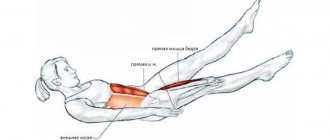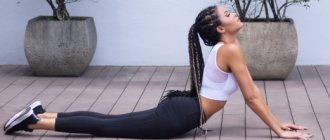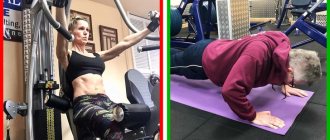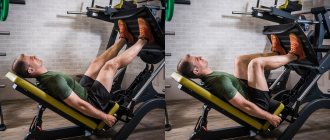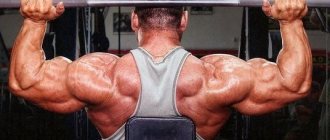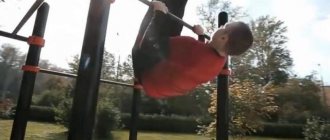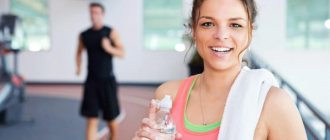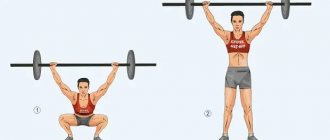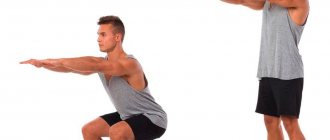Exercises to strengthen the muscles of the lower body should be performed in accordance with standard techniques, following the recommendations of a fitness trainer based on the health status of the individual. One of the most effective options for leg loads is the “Scissors” exercise.
You can do it either in the gym with additional weights or at home with your own weight.
What muscles work in the leg scissors exercise?
When performing the “scissors” exercise for the legs, it uses not only the muscles of the lower body, but also the abs, and also, if dumbbells are used, the arms, shoulders and pectoral muscles.
Leg and abdominal muscles working in the “Scissors” exercise
The main load in this case is distributed between:
- iliopsoas muscle (located in the lower abdomen and is considered one of the most difficult muscles to reach during traditional sports activities);
- rectus abdominis muscle (part of the abs that is used when performing the vast majority of exercises, regardless of the starting position, as well as the targeted muscle area);
- long abdominal muscle. It is a type of internal muscle that requires special exercises to work out. “Scissors” is one of them;
- adductor brevis (a part of the muscle with which a person can bend the leg and externally rotate the hip);
- pectineus muscle . This is the part of the thigh musculature that is located between the crest of the pubis and the pectineal line of the femur. Responsible for the ability to bend the hip and rotate it externally;
- transverse abdominal muscle (the condition of this part of the muscle determines waist circumference, the ability to maintain balance, and also maintain beautiful posture for a long time without overstraining the back);
- quadriceps . The quadriceps femoris muscle is the largest of all the major muscle groups in the lower half of the human body. This is one of the stabilizers in the “Scissors” execution.
Benefits and advantages for women
Among the main positive effects of the “Scissors” exercise on the female body and body, fitness trainers name:
- tightening the lower abdomen. In most cases, it is the lower abdomen that is the most problematic in girls of average or full build. Female physiology is such that the deposited fat mass is concentrated precisely in this area, since nature provides for the preservation of the ability for a woman to bear a child, regardless of the external conditions in which she has to be;
- the entire abdominal area becomes flatter (despite the fact that when performing the exercise the main load is on the lower part of the abs, other muscle groups in this area are also involved, although not to such a significant extent);
- strengthening and tightening thigh muscles (due to the fact that the lower limbs become more slender, the clearance between the upper parts of the legs increases, which has a positive effect on the overall appearance of the girl);
- a visible decrease in waist volume (this becomes possible by reducing the number and size of folds on the sides of the athlete);
- increasing overall body flexibility;
- strengthening the muscles in the lower back;
- active fat burning. In 7-10 minutes of performing “Scissors” in various variations, it is possible to burn up to 70 Kcal. To maintain the speed of metabolic processes, which directly affect the reduction in the amount of subcutaneous fat, fitness trainers recommend that their clients alternate exercise options within one workout. For example, as the final stage of the lesson, you can perform the classic “Scissors”, and then do this exercise with weights previously attached to the legs.
Flaws
The leg scissors exercise, along with its advantages, also has a number of disadvantages.
They must be taken into account when deciding whether to include these loads as a permanent component of the training complex:
- inability to make the abdominal muscles pronounced (despite the frequency and correctness of performing “Scissors”, it is impossible to achieve “cubes” in the lower abdomen with their help);
- the risk of harming one’s own health if the exercise is performed incorrectly (for example, failure to follow the recommended technique can lead to strained leg muscles, pain in the lower abdomen, as well as deterioration of the muscles of the back and neck);
- the presence of absolute contraindications to performing “Scissors” (ignoring these recommendations can lead not only to a decrease in the effectiveness of physical activity, but also to a deterioration in the health of a particular person);
- the presence of details in the “Scissors” technique, which must be taken into account for safe sports activities (most often such nuances, for example, the position of the chin, are not perceived by the athlete as an important detail, which increases the risk of injury during sports activities);
- low effectiveness of the exercise for people with a large amount of subcutaneous fat (due to excess weight, it becomes difficult to perform “Scissors” correctly, which means there will be no result from such exercises, regardless of their regularity).
Contraindications
The “Scissors” exercise, like other variants of physical activity, has a number of contraindications, which must be taken into account when making a final decision on the advisability of including loads of this type in a training complex.
Contraindications:
- benign or malignant neoplasms in the lower part of the body. Muscle pumping stimulates local blood circulation, which increases the rate of metabolic processes in the body. With the acceleration of metabolism, the neoplasm will be fed with blood, which can lead to both tumor growth and its transition from the “benign” to “malignant” type;
- increased body temperature (regardless of the reasons that provoked a change in its level);
- exacerbation of chronic diseases (of any type);
- inflammatory processes in the body, regardless of the area of their occurrence;
- back or lower extremity injuries;
- recent surgery (if less than 6 months have passed since the operation);
- menstruation (at the beginning of the cycle, it is not recommended to load the muscles of the lower abdomen, as this can lead to an increase in the volume of discharge and the onset of bleeding, which can only be stopped with medication);
- serious diseases of the cardiovascular system (for example, tachycardia, arrhythmia, and so on).
Leg exercise options
The leg scissors exercise can be performed in several ways, the most effective of which are:
| Exercise | Execution algorithm |
| "Bent Scissors" |
|
| "Diagonal scissors" |
|
Average level
It makes sense to switch to it if there is no discomfort or pain when lowering your legs to a third.
The order remains the same:
A set of exercises for gaining weight - basic exercises and recommendations for selecting weights for exercisesWe perform squats with dumbbells - a description of the technique of performing the exercise. Subtleties and secrets of squats for girls (125 photos)
The best dumbbell press - advice from professionals and basic variations of the basic exercise (75 photos)
- Lying on the mat, make cross movements with your legs at a height corresponding to 60 degrees.
- To enhance the effect, swings in the vertical and horizontal planes are combined.
- After completion, the legs are carefully lowered down without bending at the knees. After 5-10 seconds of rest, the algorithm is repeated.
Technique for performing female scissors at home
The technique for performing female scissors at home may vary depending on the physical fitness of the individual athlete.
Beginners
Girls who have no experience in sports are recommended to do “Scissors” like this:
| Exercise | Execution algorithm |
| Classic scissors |
The total number of approaches should be at least 3 pieces. |
| Alternate leg raises |
|
Pro
Girls who already have previous experience in sports are recommended to do “Scissors” like this:
| Exercise | Execution algorithm |
| Weighted scissors |
|
| Reverse scissors on the floor | The technique for performing this exercise is similar to the above. The only difference is the starting position. In this case, the athlete should lie on her stomach, lowering her limbs 1-2 cm to the floor with each crossing of her legs. The exercise should not provoke pain or discomfort in the back (if there is discomfort, it is recommended to reduce the load, for example, remove weights, or exclude this exercise from the training complex). The optimal number of repetitions is 10, and approaches are 5 pcs. |
For beginners
Before starting the lesson, you need to warm up. It will not take much time (5-7 minutes is enough), it will help warm up the ligaments and improve blood circulation.
Joint gymnastics, including rotation of the knees, feet, and hip area, is well suited. After this you can start executing:
Take the starting position. To do this, lie on your back and stretch your legs. Hands are placed along the body. You can grab them onto a fixed support from behind (a wall unit, a protruding edge of heavy furniture). Pull the feet towards the body, creating a 30 degree popliteal bend.
Correct breathing. Count silently from 1 to 10, adjusting each number to the phases of inhalation and exhalation. In the future, they adhere to the specified respiratory rhythm.
Perform swings. Raise your legs perpendicular to the floor (90 degree angle), spread them slightly wider than your shoulders. At the same pace, bring the right limb behind the left and vice versa.
Crossings are performed until a certain count or for a time. After which they lower their legs, take 2-3 deep breaths and exhale and make a second approach. It is recommended to do 3 to 5 repetitions. It is important to breathe “correctly” in each cycle, without straying from the initial tempo.
Scissor exercise in the gym
“Scissors” can be done not only at home, but also include this exercise for the legs and abs in a training complex intended for athletes working out in the gym:
| Exercise | Execution algorithm |
| Reverse scissors on a horizontal bench |
|
| Vertical scissors |
|
Lying on your stomach
As you know, standing still means rolling back. Therefore, having mastered the classics, we move on to the 2nd grade of the “Scissors” exercise. Precisely - in a supine position. This type of exercise is most conveniently done in the gym on an abdominal pumping machine. But you can have this machine at home, or be creative - adapt a piece of furniture, as long as the surface is hard.
This “Scissors” configuration not only adds variety, but also significantly advances our body in understanding its own capabilities. Working in a prone position, we perfectly strengthen, first of all, the back, tighten the buttocks and the back walls of the thighs.
If you start this subtype after mastering the classics, feel free to work in the correct horizontal position, alternating 10-20 swings horizontally with 10-20 swings vertically. Use your hands to hold yourself motionless on the surface. It would be ideal if you now alternate classic “Scissor” days with “Reverse” days.
See also TOP 10 most effective exercises for the buttocks.
See also:
- How to get rid of cellulite on legs and buttocks - 5 methods
- Is it possible to remove excess muscles from a girl?
- The best complex for legs for 7 days
Possible mistakes
When performing “Scissors,” fitness trainers recommend that athletes pay special attention to maintaining the technique.
The most common mistakes made not only by beginners, but also by people who regularly play sports are:
- raising the lower back from the floor while changing the position of the lower limbs (this mistake can lead to overstrain of the lower back muscles and also increase the risk of spinal injury);
- bending the legs at the knees when changing the position of the lower extremities (if the legs are no longer straight, the load on the abs is automatically reduced, which leads to a decrease in the effectiveness of the exercise);
- raising your legs too high . This mistake is often made by people with strong abs, who believe that a large distance between the floor and legs is the key to the high effectiveness of the exercise. In the initial position, the legs should be raised no higher than 90 degrees from the floor, and in the lower position, if a complicated version of “Scissors” is performed, there should be 5-10 cm between the floor and the limbs;
- neck tension in the process of moving the legs during the exercise (due to incorrect distribution of the load, athletes will not be able to achieve the most effective workout of the abdominal muscles and legs due to the rapid onset of fatigue and associated discomfort).
“Scissors” is one of the most effective exercises with which you can strengthen not only the leg muscles, but also the muscles of the abdominal region.
To achieve the desired result (for example, increasing endurance, drawing relief, losing weight, and so on), it is important for the athlete to follow the exercise technique recommended by the fitness trainer, as well as to exercise regularly, at least 3 times a week.
How to hit correctly?
At first glance, the simple process of impact is actually a rather complex combination of a number of interrelated factors in which almost all parts of the body are involved. Let's consider them separately.
Rack
First, it’s worth understanding what stands there are for working with your hands and feet:
- Left-handed (for right-handers);
- Right-handed (for left-handers);
- Frontal.
It should be noted that in boxing there are more than 10 types of stances, which take into account the transfer of body weight to any of the legs, the position of the arms, head and body. But first, it’s worth taking into account only three main ones. As for kicks, the emphasis here is on the correct transfer of body weight, turning the pelvis along the trajectory of the leg and preparing the kick itself.
Basics of correct left-handed stance (for right-handers):
- Feet are placed shoulder-width apart;
- The right foot is slightly on the toe (it is at the back), and the left foot should be placed on the entire surface of the foot and turned slightly inward to ensure stability (the left foot will be the “front”);
- The right hand is placed so that the elbow is at the level of the liver, and the fist is at the lower part of the jaw. The left one, in turn, is brought forward a little, the elbow is below the heart, and the hand is turned so that the palm is more turned towards the enemy;
- You should not raise your arms too high, as well as your shoulders themselves - in this case, the deltoid muscles will always be tense, which will ultimately lead to very rapid fatigue, and on top of everything else, it is extremely inconvenient to strike from such a position, because the trajectory of the natural movement of the joints is obviously disrupted ;
- The chin is lowered to such a level that you can protect yourself from a potential blow not only with the forearm, but also with the shoulder itself;
- The opponent will end up between the left and right hands (in the center), with neither hand covering him;
- The forward movement in the stance always begins with the “back” leg (right), and backwards with the left (“front”).
Accordingly, for a left-handed person everything is done exactly the same, only in mirror image. Regarding the front stance: both hands are at chin level, legs are shoulder-width apart and slightly bent at the knees (toes slightly inward), the body does not rotate.
How to make a fist?
A correctly clenched fist is the key to success when striking. In this case, everything is simple:
- First, the fingers of the hand are bent in the phalanges in the middle;
- Next, they are folded so that the tips of the fingers rest against the palm and the fist becomes one plane, which will be used to deliver the blow;
- The thumb is placed under the fingers from below (not from the side) to avoid injury.
Angle of application and general technique of impact
For a novice fighter, it is very important not to immediately rush into complex combinations and not to practice strikes that are technically difficult to perform. The jab and cross are ideal for starting. Each strike has its own angles and it is better to practice them with a coach, since from the outside you can see exactly how the movement itself occurs in a particular case.
To throw a jab, you need to be in a regular right or left stance. This blow is delivered with the “front” hand, for a right-hander it is the left, for a left-hander it is the right. Despite the apparent simplicity of the jab, it is very important to observe the angles and turns that the arm and body perform in order to avoid injury:
- Hands are at the chin. At the start, the fist of the striking hand should be in a vertical position, with the elbow looking down;
- While performing the movement, it is necessary to turn the hand so that the fist ends up in a horizontal position and the elbow points outward. This will help make the hand as rigid as possible;
- At the end of the movement, the kicker's arm will be fully extended. The fist is at the same level as the shoulder (it is not necessary to tuck the hand, making a straight “shoulder-fist” with a bend at the end, as the hand can be easily injured);
- Another very important detail. Being in such a stance, when the blow has already been struck, but the hand has not yet been returned back, the head must not be further than the line on which the front leg stands - this way you can lose balance;
- To return the hitting arm to its place, you need to lower your elbow down, but do not move your entire body back.
A blow such as a cross is delivered according to the same general principles, but here there is more emphasis on working with the body. The right hand is used to apply it. At the beginning of the movement, it is located at the chin. The first step is to turn the foot to start, then turn the pelvis and body so that eventually the whole body is in a frontal position. After this, the arm is extended from the shoulder (all the subtleties of the movement are preserved, as in the case of the jab), and by creating a straight line from the arm, the movement can be considered completed. The hand is returned to its place by turning the body and lowering the elbow into the liver area.
Kicks
For a beginner, kicking may simply be useless - this is the case when the only right decision would be to contact a trainer. However, it is worth at least understanding how to deliver such a blow. Let's take, for example, the most commonly used low kick:
- From a normal stance, the foot of the front leg turns outward slightly;
- At this time, the back leg, with the help of twisting the pelvis, is carried forward and with an amplitude, sharp movement, it is launched into the desired area for the strike;
- You need to hit exclusively with your shin (bottom, middle or top - everyone decides for themselves what is comfortable for them), and not with the instep of the foot;
- The blow is made while exhaling, after which the leg returns to its place, just as it was thrown out - it needs to be bent.
It is advisable to practice low kick on a heavy bag.
Important little things
There are some details that are not always paid attention to. But they are extremely important. Eg:
- When striking, you need to clench your fist as tightly as possible and tense your hand. While wearing boxing gloves for training, some beginners forget about this, and while working without them, they “successfully” break and dislocate their fingers;
- The fist is compressed strongly even during the strike. When clenching a fist, a lot of muscles work, and if you constantly keep it tense, even when you’re just moving, you can quickly clog the muscles and greatly lose the speed and hardness of the blow;
- All strikes start from the feet. To understand what the difference is between a blow delivered simply by hand and one performed according to technique, you can take an ordinary stone or cannonball and launch it, first from the shoulder, without turning the body or using the legs, and then according to all the canons . The distance the stone will fly will be different in these two cases.
